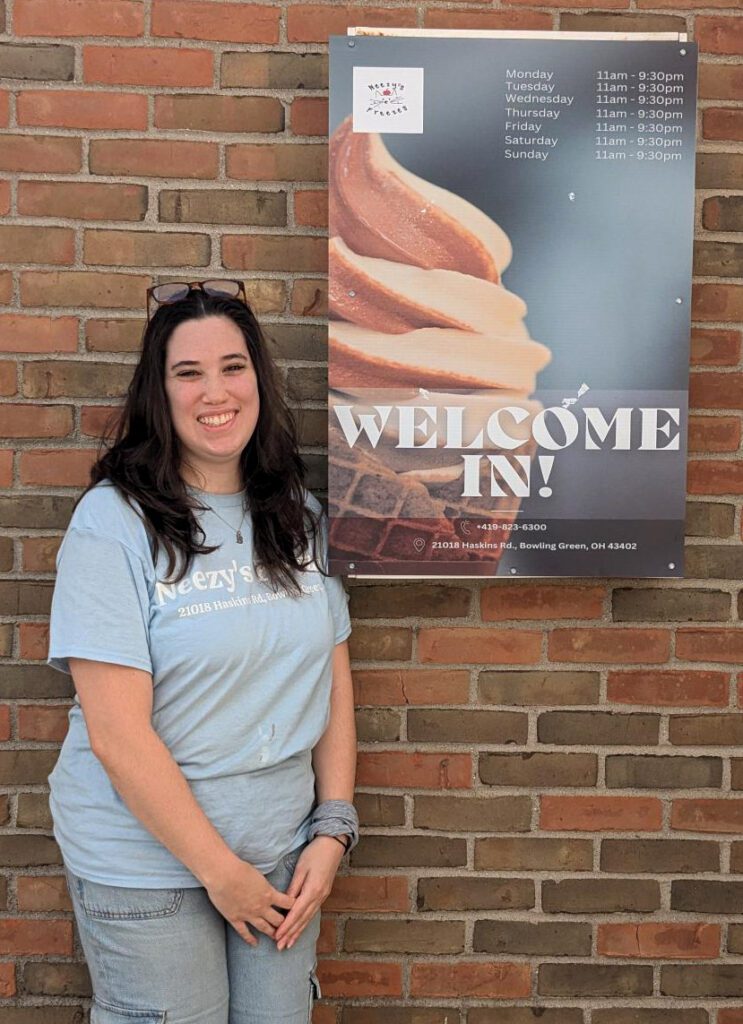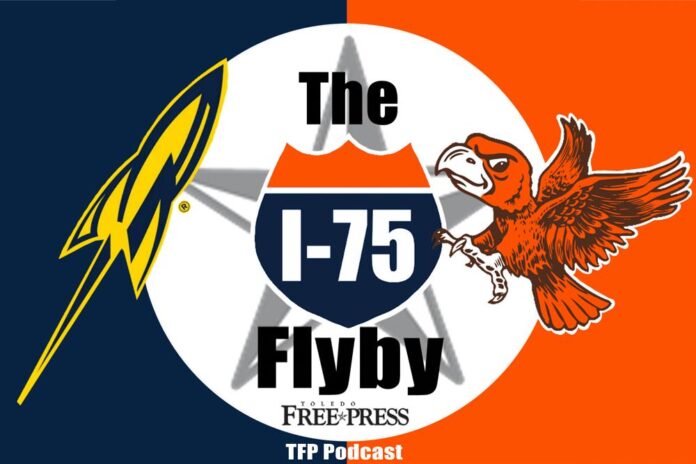Toledo Rockets defused by Ball State
Story by Max Alfonso | Photos by Kyle Brown
CLEVELAND – Going into the locker room during halftime, No. 2 Toledo women’s basketball team was up by three points and feeling confident they could knock off No. 1 Ball State to claim the MAC Championship at Rocket Arena on Saturday.


After all, the Rockets put down Ball State 70-66 the last time they met nearly a month ago.
But Toledo blew the half-time lead, and Ball State outlasted Toledo 65-58 behind a 4th quarter 14-point surge by forward Alex Richard, who finished the game with 28 points and nine rebounds. She had help by point guard Ally Becki, who stuffed the stat sheet with 12 points, five assists and seven rebounds, helping to earn the Cardinals their first MAC Championship title since 2009.
Richard was named to the All-MAC Second Team and Tournament Team, along with Becki, who was crowned the MAC Player of the Year and was First Team All-MAC, as well as the tournament MVP.
This is the second straight year Toledo will not make the NCAA tournament. The Rockets made it to the Big Dance two years ago under Tricia Cullop, who left after 16 seasons to take the head coaching job at the University of Miami (Florida).

After three seasons at Monmouth, Ginny Boggess was hired to replace Cullop and will likely continue her first year with an invite to play in the Women’s Basketball Invitation Tournament (WBIT). Both selection shows are on Sunday, March 16.
In the media room after the game, Boggess said she was proud of the entire roster and how far they have come as team.
“I’m really excited that because of our work in the regular season, this won’t be the last time these two wear this jersey,” Boggess said, referring to Sammi Mikonowicz and Khera Goss, who were sitting next to her. Both seniors were named to the All-MAC tournament team.

Championship game notes
For all three tournament games, Toledo’s Nan Garcia, named 6th MAC Player of the Year, was moved into the starting lineup, replacing Jessica Cook. Garcia responded with back-to-back games of double-figure scoring. But in the championship game, Garcia had five turnovers, was blocked several times under the net, and finished with only three points, making only one of her eight shots.

Toledo found a bit of success with Cook, who made all four of her shot attempts to finish with eight points, but found herself in foul trouble with four fouls.
Toledo native Kendall Carruthers led the way for Toledo with 17 points, making seven of her nine shot attempts.
Rossford’s Mikonowicz and Goss combined for 19 points for Toledo.


After the game, Boggess pointed out that second chance points were a big turning point in the game. Toledo had five and the Cardinals had 11.
“I told them when I took the job that their legacy is already cemented with the three championships,” Boggess said, talking about her seniors. “If they teach these young kids how to win, then their legacy will live on. Our future is because of them buying in and letting us do our jobs.”
When the season concludes, Toledo will lose five key pieces from a team that has won a lot of big games and an NCAA tournament game over Iowa State in 2023. It was the first Rocket win in the NCAA tournament since 1996.
“I’m really grateful for what the Toledo provides us, to create that elite student athlete experience. We’ve got something really special here,” Boggess said.
Toledo men lose in semifinal
No. 4 Toledo men’s basketball lost to the No. 1 seeded Akron in the semifinal Friday night with a score of 100-90. They finished the season with a 18-15 record, their eighth consecutive season with a record over .500.
The men have won the MAC regular season title the past four seasons in a row, but woes in Cleveland have prevented an NCAA tournament appearance. This year they finished fourth after they lost six of eight games to close the regular season. Toledo hasn’t made the NCAA tournament since 1979-1980.
Toledo started four sophomores, so you would think next year they should be much improved, being that they have much more experience. But with the transfer portal, you never know what could happen. After last season, Toledo lost three starters to the portal.
In some ways, it was a miracle Toledo finished the year 18-15. According to KenPom, Toledo finished the season last in the MAC in defensive efficiency and 7th in 3p%. Not a winning recipe.
Toledo men’s basketball will likely not play in a postseason tournament.

Chorus frogs emerge in our metroparks

TOLEDO – Everywhere there are signs that Mother Nature is awakening from winter’s slumber. The timing is about right; On Thursday, March 20, the astronomical first day of spring is on the vernal equinox.
Most of the early signs are subtle – buds swelling, skunk cabbage emerging, eagles nesting. More obvious is the growing song along Metroparks Toledo’s Wabash-Cannonball Trail, where vernal pools are welcoming chorus frogs and spring peepers settle in and serenade the opposite sex with their song.
We’re just in the opening act of their performance. The two species are small and blend in well with their environment. They may be difficult to see, but their loud songs are distinctive and easy to identify.
Chorus frogs have a loud quavering call, usually described as a fingernail running down a comb, only its tone and delivery can carry a kilometer away and it is heard day and night. In some Metroparks Toledo locations, approaching the pools can be deafening.
Spring peepers use a single high peep, described as sweet and melodious.
Both species will be performing for several weeks.
In future weeks, there will be others – 10 frog and toad species – each with its distinctive song. And then there will be our songbirds.
There’s so much to look forward to on Metroparks Toledo trails.
BGSU hires legend Eddie George & MAC tourney roundup
On The Flyby Sports Podcast, co-hosts and school rivals Chas McNeil and Max Alfonso dissect all of the matchups and schedules for the 2025 MAC Tournament on both the men’s and women’s sides.
For this episode, McNeil shares the news that Bowling Green has hired Ohio State and Tennessee Titan legend Eddie George to be their 21st head coach in program history, replacing Scot Loeffler, who left to pursue the quarterbacks coach job for the Philadelphia Eagles.
Main topic is MAC Tournament play and predictions, but they also recap the past two weeks of action for winter sports, including a playoff run by BGSU hockey and the start of MAC play for the baseball teams; and select their athletes of the week.
New episodes of the The Flyby Sports Podcast drop every Saturday.
The Flyby Sports Podcast is a production of the Toledo Free Press.
Football legend Eddie George hired as new BGSU head football coach

BOWLING GREEN – A run-of-the-mill introductory press conference hosted a small crew of local journalists, all eager to ask questions about the future to the new coach. But the introduction of 1995 Heisman winner and new Bowling Green head coach Eddie George on March 10 was anything but run-of-the-mill.
In fact, it mirrored a red-carpet event with a heavy focus on George’s well-known accomplishments over his long and successful career.
George was joined by hundreds of adoring Bowling Green and Ohio State fans lined with pictures, jerseys and footballs, hoping they would be lucky enough to get as much as an initial signed on their memorabilia.

“I saw the news on Saturday morning and my jaw hit the floor,” exclaimed Falcon fan Steve Leid. “Then yesterday at work, a friend of mine got a notification on his phone saying that it was a done deal, and wow, there has just been a buzz in the air ever since.”
Leid was clutching four images on printer paper; two were of the initial announcement released by BGSU and one was of a diving George hurdling a defender during his Ohio State days from 1992-1995. The final image was the most telling of the hire. It was a simple picture of George standing on the sidelines during his coaching time at Tennessee State University, which was the last place he coached, which was from 2021-2024.
Yes, the celebrity of the hire brings a lot of publicity to BGSU, as well as many recruits who will inevitably be excited to play for the all-time rushing leader for the NFL’s Tennessee Titans.
What George did at Tennessee State was exactly what got him hired. Through his four years at TSU, he was able to accumulate back-to-back winning seasons for the first time since 2016-2017, in addition to making the FCS playoffs for the first time since 2013.
“Urban Meyer and Dave Clawson both made the exact same remark to me, and I put this in my coaching profile: Someone who is always building on what we have and is not focused on what we don’t have,” BGSU’s athletic director Derek van der Merwe said.

That was the key to this slam dunk hire by the Orange and Brown – someone who can succeed no matter the circumstances, a characteristic that George displayed time and time again in his playing and coaching career.
George’s first collegiate touchdown was scored in Columbus, Ohio against none other than the Falcons. With a mighty career sparked by that milestone at BGSU, it seemed almost fated that the legend would become a Falcon.
“It’s been so long…it was my freshman year and that was actually the touchdown that started ‘Touchdown Eddie.’ Flying in here to Ohio and coming back to this region, to this part of the country…it brought back just a rush of memories. The sunsets are different here and the community is so strong,” George said.
Despite saying he would embrace the state of Ohio, there was one crucial location in the state that the coach alluded to which would be a priority in the most hated way.
“I don’t embrace it,” he said about the Toledo rivalry. “There’s only one thing that we are going to do. Put that ball in the dirt and let them feel the iron fist,” George proclaimed.
The first true test for the Buckeye and Titans legend will be on Aug. 28 when the Falcons will play their first game of the 2025 season against Lafayette at Doyt L. Perry Stadium in Bowling Green.
To get a true taste of the rivalry, it will be a bit longer: The home game is scheduled for Oct. 11, the first time that George will battle his new “team up north.”
“What I do know is that we are going to play fast, we’ll be physical, we’ll be disciplined and we will let the scoreboard take care of itself,” George told the media, fans and BGSU. “That’s the goal; we will be physical.”

Neezy’s Freezes serves Bowling Green
BOWLING GREEN – If at first you don’t succeed, try, try again. Though perhaps cliché, this expression is proving true for Neezy’s Freezes, a new ice cream store in Bowling Green.
Neezy’s Freezes, formerly the ice cream shop Sundaze, opened in the fall, adding a new chapter to the ice cream venue’s history.
While to some it may seem strange to establish a new ice cream place in the same venue as one that previously failed, Neezy’s Freezes owner Deniz Ilgin is working to ensure Neezy’s is successful.

Ilgin had the patio area renovated, the parking lot repaved, added to the kitchen and repainted and decorated the interior of the store. But renovations aren’t the only way Ilgin is setting Neezy’s Freezes apart from Sundaze.
Ilgin has co-ownership with her parents, who also own Reynolds Garden Cafe in Toledo. Ilgin believes their experience and guidance will help set her business apart.
“They have so much passion for what they do. That comes across in the food, which I think draws people in,” said Ilgin.
While the venue uses the ice cream machines previously used by Sundaze, Neezy’s Freezes offers more than just ice cream, serving coffee drinks, hot dogs, burgers, barbequed beef, french fries, cookies, cakes and more.
Despite all of Ilgin’s hard work, starting a small business is not without its challenges.
According to the Chamber of Commerce, 18 percent of small businesses close within their first year, 50 percent close after five years, and approximately 65 percent close by their 10th year in business.
While this could be seen as a bleak statistic, Ryan Holley, assistant professor in the College of Business at Bowling Green State University and small business owner, said small business closure or failure is not always because a business couldn’t establish itself; sometimes it’s because the owner is more interested in maximizing profit than in establishing a community staple.
“The small business owner might have a mom-and-pop restaurant, and that’s their entire character, what defines them as a person. Their identity is in this restaurant, where the entrepreneur is just OK. It’s an asset. Let’s sell it,” Holley said.
Ilgin falls into the former category, meaning her desire for the business’s longevity could improve her chances of success.


“I had always worked in my parents’ restaurant, and I really liked that. I liked being able to talk to people and have interpersonal interactions every day instead of being at a desk. And I really like the community that you can build when you own your own business,” Ilgin said.
Holley also highlighted why small businesses may have a tougher time succeeding than large corporations.
“When you take on ownership of a small business, you are responsible for everything. You are the marketing department, the human resources, the operations, the finance. Larger businesses have an ability to attract specialized talent,” Holley said.
“Whereas a small business, you don’t have that, and you might not have access to the same education or depth of knowledge,” he noted.
Neezy’s Freezes is located at 21018 Haskins Rd. More information about the restaurant can be found on their Facebook and Instagram pages.

Op-ed: Outlining problems with CCNO as ICE detention center
The Corrections Center of Northwest Ohio is set to become an Immigration and Customs Enforcement (ICE) detention center. Below are a few things I think the jail board should have been told before voting.
ICE’s rhetoric labels every immigrant a criminal, but sheriffs already have the authority to arrest people who commit crimes; they do this every day. And while the vast majority of the people who commit crimes are U.S. citizens, of course law enforcement arrests people born in other countries. What the jail board voted to do instead is to start incarcerating people who are not accused of crimes.
ICE detention is technically “civil” confinement, but it takes place in a criminal jail. You read that right. ICE is one of the few agencies that has the authority to put people in criminal jails while they are navigating a civil legal process. They have the authority but they don’t need to use it. It’s a choice made through political considerations rather than what’s good for our communities.
Incarcerating someone is a serious decision. It’s separation from their family, job and home. If it seems inhumane to put people navigating a civil process in a criminal jail, that’s because it is.
During the first Trump administration, the Ohio Immigrant Alliance worked with Ohio families dealing with a loved one’s detention and deportation. Maryam Sy interviewed 255 individuals and we wrote a book about their experiences with Suma Setty at the Center for Law and Social Policy.
We talked to fathers whose children became depressed, and even suicidal, after their parents were detained. We talked to mothers trying to hold down jobs and care for young children while they worried about the future of their families. We talked to families in foreclosure. We saw loving relationships fracture due to the stress of detention and deportation. We talked to men who were deported in straight jackets, unable to make themselves board a plane to a country that had tortured them.
These Ohioans had been in the U.S. for 10 and 20 years or more. Some fled genocide. Some had been able to buy homes, open businesses and even employ Americans. These are the people CCNO is agreeing to detain and help deport. As Lucas County Sheriff Mike Navarre said, when announcing his opposition to the ICE contract, “Nobody has a viable solution to what will happen to these children. Until they figure it out, I will not support mass deportations.”
Another thing to know is that people can simultaneously be eligible for deportation and eligible for a green card. For example, many of the people we work with are married to U.S. citizens. They applied for green cards and are waiting for the process to conclude — that can take decades because of how our laws were designed. The government has a choice about whether to allow them to continue to pursue that status, or put them in line for deportation. During the first Trump administration, and now in the second, the government chose the path of breaking up families.
Finally, the CCNO board should have been told that immigration detention is indefinite. There’s no time-limited “sentence” like in a criminal case. Executive director Dennis Sullivan told board members that the average length of stay would be 40-45 days. But that is based on Biden-era figures, which included people who were deported quickly at the border.
That’s not how the Trump administration operates. They are arresting people who can’t immediately be deported, like people who have appeals pending. According to the American Immigration Council, people with cases in immigration court are often held for six months or longer.
During the first Trump administration, we worked with individuals who were detained for 12 months or more — some up to four years — in Ohio county jails. These jails are not set up for long-term incarceration. But, they are required to provide medical care. The Butler and Morrow County jails tried to scrimp on medical costs and were sued. Judge Sarah D. Morrison, a Trump-appointee, blasted the Morrow Jail for creating an “unconstitutionally acceptable environment,” in a case brought by the ACLU of Ohio.
Earlier this year, the ACLU of Ohio and other organizations sent a letter to counties outlining their legal obligations under ICE contracts. It doesn’t appear that anyone, other than Sheriff Navarre and Lucas County Commissioner Pete Gerken, read it. A 2020 lawsuit against Butler County Jail, which is based on civil rights violations by corrections officers, remains pending.
The CCNO board will soon find itself at the center of family separations. It’s not too late to choose a different path, one that focuses on local needs, instead of engaging in a federal political battle that will harm our community members.
Everyone in Ohio — whether we were born here or somewhere else — wants the same thing. To live in a safe place and take care of our families. Said an Ohio father who was deported after months in an Ohio county jail, “I’m a human, like everybody else. Nobody [is] better than nobody, man.”

























